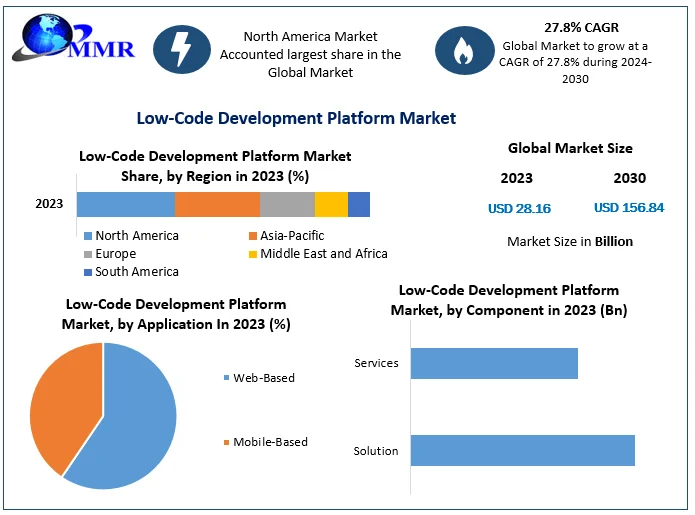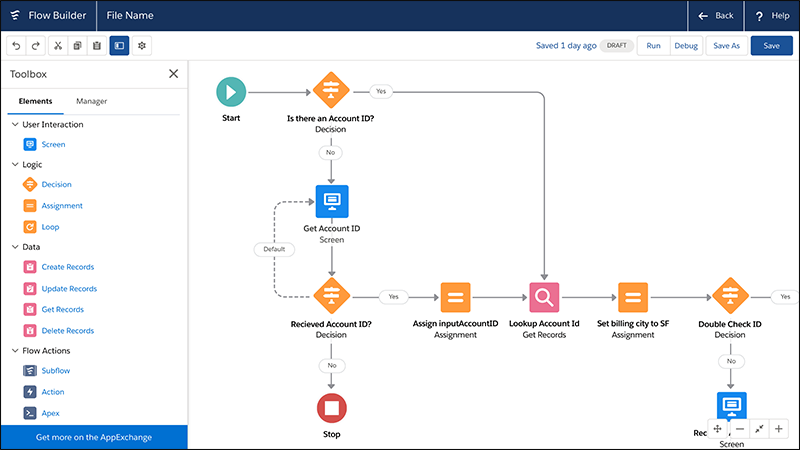Handy Advice For Deciding On Low-Code Platform Recommendations
Wiki Article
Benefits Of Developing Applications Using Low-Code With Regard To Accessibility For Non-Developers
Low-code app development improves accessibility by non-developers (often called "citizen-developers") due to several key elements.
Drag-anddrop Builders: Lowcode platform have drag-and-drop interfaces that enable non-developers to create visually appealing applications, without needing code. This makes the process of developing easier for people with technical background.
WYSIWYG editors: These "What You See Is What You Get" editors allow users to create workflows and interfaces that are identical to the finished version. This makes it easier to learn and use.
Simplified Logic and Workflow Design:
Visual Workflow Design: Users can easily design business process and application logic with diagrams, models, and flowcharts. They are much easier to work with than traditional coding.
Pre-built Logic Components: Low-code platforms typically contain pre-built logic components (e.g. statements that are conditional loops, conditional statements) which can be easily modified, eliminating the need for complicated programming.
Reusable Templates and Components
Libraries of prebuilt templates: Low-code platforms usually offer libraries of templates for the most popular types of applications. This gives non-developers the opportunity to start with a solid foundation and then modify it according to their needs.
Reusable Widgets and Modules Users can make use of the widgets that can be reused. This allows for a simpler creation and helps to reduce the need for extensive knowledge.
Guided Development and Tutorials:
Step-by-Step Guides: Platforms often offer a set of development guides, tutorials, and on-screen suggestions to help non-developers with developing applications.
Interactive Tutorials - Interactive tutorials which allow you to interact with the platform can help you learn and gain confidence.
Integration with existing tools
Seamless Integration - Low-code platforms are easily integrated into existing systems and tools for business (e.g. ERP CRM, ERP) that give even non-developers to build apps that are compatible into their workflows.
APIs Connectors: APIs are built into applications to make integration easier. This allows non-programmers who do not have coding skills, to connect to external services.
Collaboration Features:
Team Collaboration: real-time collaboration, shared workspaces, and shared workspaces permit business analysts, non-developers, and other stakeholders to effectively work alongside professional developers.
Access Control Based on Roles: Developers who are not developers are able to be assigned roles and access levels that permit them to contribute without compromising functionality or security.
Automated Testing and Debugging
Low-code platforms often come with an integrated testing and debugging tools which makes this process easier. Developers who are not developers can now make sure that their applications are working properly.
Error Highlighting: When issues occur, the system highlights the issue and offers solutions. It also guides users through the process of troubleshooting.
The main benefit of developing applications using low-code in terms of accessibility to non-developers stems from its ability democratize the process of development. Low-code platforms enable businesses to take part in the development and maintenance of apps by offering visual tools as well as a guiding user experience. This bridges the gap between the technical implementation and business requirements. Read the best my latest blog post about Low-code Platform for application development for website recommendations including develop web app, rapid app development, application modernization, jdbc server, app platforms, application modernization, cross platform mobile development, push notifications android, mobile app development platforms, build a docker container and more.

Benefits Of Low-Code Application Development In Terms Of Flexibility And Scale
Low-code app development provides several advantages, including scaling and flexible application design. These are important for creating applications that can adjust to the changing demands and expand with the needs of the business. Here are a few of the main advantages.
Cloud-Based Platforms: A lot of platforms for low-code are cloud-based. They permit applications to grow quickly and smoothly using the cloud infrastructure. This allows businesses to manage increasing loads without worrying over server management.
Auto-Scaling Feature: Built-in features that automatically scale resources in order to meet demand can ensure consistent performance without manual input during peak hours.
Flexible Architecture:
Modular Application Design: A low-code platform allows for modular design of application. Components are able to be independently tested, developed and expanded. Modularity improves the flexibility of an application and makes it simpler to upgrade or expand certain parts of an application without impacting the whole system.
Microservices Integration Microservices Integration: Microservices Architecture support lets applications to be constructed as a collection of loosely coupled services, enhancing both flexibility and scalability.
Customizable Solution:
Extensibility: Low-code platforms generally allow for customized scripting and programming which allows developers to extend the functionality of applications beyond the ones that are available. This allows companies to meet the requirements of their particular business.
Third-Party Integrations: Businesses may incorporate additional functions and services into their apps by integrating with APIs and third-party services.
Agile Development and Deployment
Continuous Delivery and Deployment: Low-code platform support agile methodologies enabling continuous integration, continuous delivery (CI/CD). This enables rapid deployment of new features and updates, ensuring that the applications are able to evolve rapidly in response to user feedback and market changes.
Iterative Design: Because low-code is an iterative process it is possible to incrementally improved and then scaled up. This allows for controlled growth and reduces the risks of large-scale changes.
Resource Optimization
Low-code platforms offer tools to monitor and manage application performance and help to optimize the use of resources. This ensures that resources are efficiently used and can be scaled either up or down depending on actual demands.
Load Balance: This feature allows the application to handle massive traffic by distributing workloads across several servers. It also ensures that the application's performance is constant.
Global Reach
Multi-Region deployment: Low-code systems typically allow deployment in multiple geographical regions. This allows companies to offer low-latency service to users across the globe. This is essential, especially for applications with global users.
Localization Support The built-in support for localization allows applications to be easily tailored for various languages and needs in different markets.
Maintenance and updates:
Simple Maintenance: The graphic and modular nature of low-code programs simplify maintenance tasks making it possible for bugs and updates to be made quickly, without extensive downtime.
Version Control: Integrated versions control systems permit the safe release of rollbacks and updates. Older versions can be restored in the event that they're needed.
Cost Efficiency:
Reduced development costs: Low-code platforms allow for a reduction in the development costs by removing the requirement to code extensively. This allows applications to be scaled without an increase of development effort or expense.
Pay-As.-You-Go: Many lowcode platforms offer flexible price models, such as pay-as.-you-go. They align prices with usage and growth to provide financial flexibility.
Overall, the scalability and flexibility advantages of low-code application development let businesses build robust, adaptable, and scalable applications efficiently. These platforms permit rapid adjustments to meet changing requirements as well as efficient utilization of resources and continuous improvement, ensuring that applications develop and grow with the business. See the best additional resources for Enterprise application development with Low-code Platform for site recommendations including push notifications android, rapid application design, rad application development, database in azure, cross platform app dev, azure sql, cloud software applications, push notifications, paas service, mobile app development platforms and more.

Advantages Of Low-Code Application Development In Terms Of Limitations And Customization
Low-code app development is a well-balanced solution that provides significant benefits in terms of overcoming limitations while also allowing customization. Here are some benefits:
Beating Complexity Barriers
Simplified development: Platforms that use low-code reduce the amount of work by supplying pre-built components and templates that allow for rapid development and deployment for more complex applications.
Guided Workflows Many platforms have workflows and wizards that help developers through complicated processes. This helps to reduce the risk of making mistakes while also ensuring consistency.
Scalability Solutions
Scalability is a part of the Low-code platforms typically include capabilities that permit an architecture that is scalable. Applications can handle increasing demands with little changes.
Performance Monitoring: Integrated performance monitoring tools and optimization make sure that applications are as efficient as they can be, regardless of the size of their application.
Security and Compliance
Integrated Security Features: Low-code platforms come with built-in security measures like encryption, access control based on role, and automated compliance checks that address common security concerns.
Platforms frequently update their security and compliance measures to ensure that applications are protected against new threats.
Customization capabilities:
Extensibility:
Low-code platforms allow developers to extend functionality beyond standard offerings by integrating customized code.
Developers are able to create customized plugins and modules with functions that can be specifically tailored to meet the needs of specific businesses.
APIs Integration:
API Support: The extensive support for APIs allows seamless integration with external systems and services, which allows the creation of a wide range of customizations and connections.
Third-Party Services : Low-code platform typically provides pre-built connections to well-known services offered by third parties, making integration and customization easier.
Flexible UI/UX Designs:
Customizable User Interfaces: Developers can alter and design user interfaces that comply with the requirements for branding and usability, creating a tailored user's experience.
Responsive Web Design The built-in design responsive features allow applications to be customized according to the device and screen size.
Making Business Logic more flexible is simple:
Visual Workflow Builds Visual tools permit the modification of workflows as well as business rules, and also to create complex, tailored processes.
Platforms include conditional Logic that allows the creation of custom scripts that address particular scenarios and business rules.
Data Management:
Custom Data Modeling: Designers define custom models to fit particular requirements of the application. They can tailor processing of data according to a company's specifications.
Advanced Data Processing: The integration of advanced tools and capabilities for data processing allows customizations in the way data is analyzed within an application.
How do you balance personalisation and limitations:
Frameworks, Standards and Standards:
Low-code platforms encourage industry standards and best practices. This results in applications of high-quality that are robust and safe.
Governance Frameworks. The built-in governance frameworks to ensure that modifications aren't detrimental to the integrity, security or security of the application.
Feedback and iterative development:
Rapid Prototyping. The ability to speedily prototyping and testing modifications lets developers tweak the application based on user feedback. This helps refine the app to better meet users' needs.
Low-code platforms allow for constant improvement through ongoing customization and enhancing the platform as requirements of business evolve.
User Empowerment
Enabling Citizen Developers by giving non-developers the capability to personalize their apps using easy-to-use interfaces as well as low-code platforms, they increase the number contributors who can enhance and customize applications.
Support and Training: A lot of platforms provide extensive assistance and training to help users in making effective customizations without compromising stability or performance.
Low-code development is a potent framework that permits a lot of customization while addressing any shortcomings. This ensures that companies can develop and maintain applications that are both functional and specifically tailored to their requirements, while maintaining the highest standards of security, quality, and scalability.
